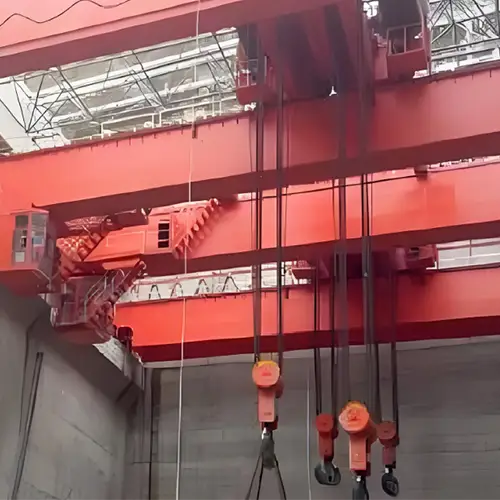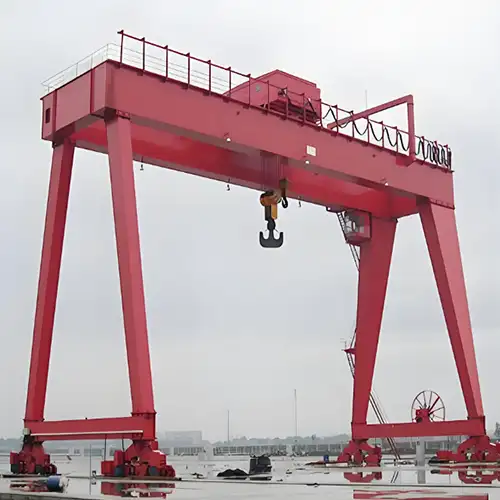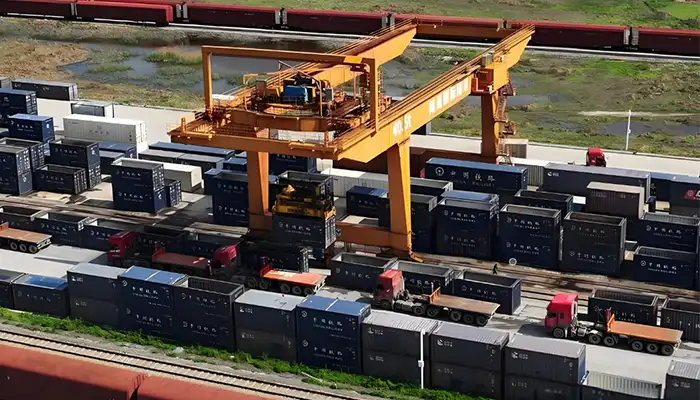
Heavy-Duty Crane Classification in the USA and China
Heavy-duty crane classifications in the USA and China focus on load capacity, safety standards, and industrial applications across sectors.
Heavy-duty cranes are essential tools in various industries, designed to lift and move substantial loads safely and efficiently. These cranes are commonly used in construction, manufacturing, shipbuilding, and other sectors where heavy lifting is required. Their robust construction and advanced engineering enable them to handle significant weights, ensuring smooth operations in challenging environments.
Understanding crane classifications is crucial for selecting the right equipment for specific tasks. Crane classifications provide insight into the operational capabilities, limitations, and duty cycles of different cranes. This knowledge helps operators and project managers make informed decisions, ensuring they choose a crane that meets the requirements of their lifting applications while adhering to safety standards.
There is a close relationship between heavy-duty cranes and large-capacity cranes. While all heavy-duty cranes are built to handle significant loads, large-capacity cranes specifically refer to those designed for lifting heavy weights, typically ranging from 30 to 100 tons or more. These cranes, whether they are overhead or gantry types, play a vital role in projects that demand high lifting capacities. By understanding both the classifications and the capacities, businesses can optimize their operations and improve efficiency, ultimately leading to safer and more productive work environments.
Heavy-Duty Cranes
Heavy-duty cranes are specialized lifting machines designed to handle large and heavy loads that standard cranes cannot manage. These cranes are characterized by their robust construction, high lifting capacities, and the ability to operate in demanding environments. Typically, they are classified based on their duty cycle, which indicates how often they can be used without risking damage or safety.
Heavy-duty cranes are defined by their capacity to lift weights ranging from several tons to over a hundred tons, depending on the model and design. These cranes are engineered to provide high performance in continuous and intensive applications, making them essential in industries where heavy materials need to be moved reliably and safely.
Typical Applications in Various Industries
Heavy-duty cranes find applications across a wide range of industries, including:
- Construction: Used for lifting large beams, concrete panels, and other heavy materials essential for building structures.
- Manufacturing: Employed to move heavy machinery, equipment, and raw materials within production facilities.
- Shipbuilding: Essential for lifting and positioning large hull sections and major machinery components in shipyards.
- Mining: Utilized to handle heavy mining equipment and materials, often in rugged and remote locations.
- Steel and Metal Fabrication: Critical for lifting heavy metal sheets, beams, and fabricated components during the manufacturing process.
These applications highlight the versatility and necessity of heavy-duty cranes in maintaining efficiency and productivity in various sectors.
Importance of Selecting the Right Crane for Specific Tasks
Selecting the appropriate crane for a specific task is vital for ensuring operational efficiency and safety. The right crane must align with the load type, weight, and frequency of use. Using an undersized crane can lead to equipment failure, while an oversized crane may result in unnecessary costs and inefficiencies.
Considerations when selecting a heavy-duty crane include:
- Load Capacity: Understanding the maximum weight that needs to be lifted ensures the crane can handle the job without risk.
- Duty Cycle: Knowing how often the crane will be used helps determine its classification, ensuring it meets the demands of the work environment.
- Operating Conditions: Factors such as space constraints, ground conditions, and environmental challenges play a critical role in crane selection.
By carefully assessing these factors, operators can choose the right heavy-duty crane, enhancing productivity while minimizing safety risks and equipment wear.
Heavy-Duty Crane Classifications in the USA
In the United States, heavy-duty cranes are classified into different categories based on their operational capabilities and the nature of their usage. Understanding these classifications helps businesses select the right equipment for their specific lifting needs.
Classifications Overview
Class F: Continuous Duty Cranes
Class F cranes are engineered for continuous operation, making them the ideal choice for environments where frequent lifting is essential. These heavy-duty cranes can handle substantial loads over extended periods without overheating, ensuring reliable performance in demanding applications.
Typical Configurations
- Double Girder Design: Provides enhanced stability and allows for higher lifting capacities, making it suitable for the heavy loads typically encountered in manufacturing and construction.
- Top-Running Setup: Maximizes lifting heights and optimizes floor space, making it suitable for applications that require significant vertical reach.
Capacity Range
Class F cranes generally have a lifting capacity that ranges from 20 tons to over 100 tons, making them ideal for heavy manufacturing processes.
Key Features
- Advanced Hoisting Systems: These systems ensure precise load control, which is critical for applications requiring high accuracy.
- Heavy-Duty Frames: Designed to withstand rigorous use in critical environments, ensuring long-term reliability and durability.
- Efficient Braking Systems: Enhance safety during continuous operations, significantly reducing the risk of accidents.
Applications
Class F cranes are commonly utilized in industries such as automotive manufacturing, steel fabrication, and construction. Their robust design and advanced features make them invaluable for maintaining productivity and safety in heavy lifting tasks.
Class E: Intermittent Duty Cranes
Class E cranes are specifically designed for intermittent use, making them suitable for applications that involve frequent starts and stops. While they are capable of handling heavy loads, they are not intended for continuous operation.
Typical Configurations
- Single Girder Design: This configuration is often lighter and more economical, making it ideal for specific tasks where budget and space are considerations.
- Underslung Design: Offers versatility in environments with low headroom, allowing for efficient operation without compromising headspace.
Capacity Range
Class E cranes typically have a lifting capacity that ranges from 5 tons to 50 tons, making them ideal for various industrial settings that require moderate lifting capabilities.
Key Features
- Variable Speed Controls: Allow for flexible operation, enabling operators to adjust lifting speeds according to specific task requirements.
- Durable Components: Designed to withstand the demands of intermittent lifting tasks, ensuring reliability and longevity in varied working conditions.
Applications
Class E cranes are commonly used in environments such as workshops, assembly lines, and smaller manufacturing facilities, where heavy lifting occurs at intervals rather than continuously. Their design and features facilitate effective operation while prioritizing cost-effectiveness and versatility.
Class D: Moderate Service Cranes
Class D cranes are specifically designed for moderate service environments, making them ideal for applications that involve lighter loads and less frequent lifting activities. These cranes are commonly utilized in workshops and smaller manufacturing settings where heavy lifting is not a primary focus.
Typical Configurations
- Single Girder Bridge Design: This configuration is lightweight and suitable for light industrial tasks, providing a cost-effective solution for applications that do not require heavy lifting capabilities.
Capacity Range
Class D cranes typically have a lifting capacity ranging from 1 ton to 30 tons, making them suitable for a variety of light industrial applications.
Key Features
- Basic Hoisting Mechanisms: Designed for ease of operation, these mechanisms simplify the lifting process, making it accessible for operators of varying experience levels.
- Simple Control Systems: These systems help reduce the learning curve for operators, enabling quick adaptation and efficient use in light-duty applications.
Applications
Class D cranes are frequently employed in environments such as assembly lines, small manufacturing facilities, and maintenance workshops, where the need for heavy lifting is limited, but operational efficiency and reliability remain essential.
Typical Crane Types and Applications
Heavy Duty Overhead Cranes
Heavy-duty overhead cranes are vital for a wide range of industrial applications, offering versatility and robust lifting capabilities. These cranes operate on two parallel runways and feature a bridge that supports the hoist.
Typical Configurations:
- Single Girder Overhead Cranes: Ideal for lighter applications, these cranes offer an economical solution while providing efficient lifting capabilities in smaller facilities.
- Double Girder Overhead Cranes: Designed for high-capacity lifting tasks, these cranes deliver enhanced stability and safety, making them suitable for demanding industrial environments.
Capacity Range:
Heavy-duty overhead cranes can handle loads ranging from 1 ton to over 100 tons, catering to various industries and applications.
Applications:
- Automotive Manufacturing: These cranes are essential for moving heavy engine components during assembly processes, ensuring efficiency and precision.
- Aerospace: Heavy-duty overhead cranes are employed to handle large fuselage sections, providing the necessary support and accuracy in assembly lines.
- Steel Fabrication: They are utilized to lift and position heavy steel beams and plates, facilitating the construction and assembly of large structures.
Key Features:
- High Lifting Heights: These cranes maximize workspace by allowing lifting at greater heights, making efficient use of vertical space.
- Customizable Hoist Speeds: Operators can adjust hoist speeds to accommodate specific lifting requirements, enhancing operational flexibility.
- Advanced Safety Systems: Equipped with features such as overload protection and emergency stop functions, these cranes ensure safety during heavy lifting operations.
Heavy Duty Gantry Cranes
Heavy-duty gantry cranes are highly versatile lifting solutions, perfectly suited for outdoor and large-scale applications. They come in both fixed and mobile configurations, allowing for flexibility in various operational settings.
Typical Configurations:
- Rail-Mounted Gantry Cranes (RMG): These fixed units operate along dedicated tracks, making them ideal for use in shipping and rail yards where precise movements are essential.
- Rubber-Tyred Gantry Cranes (RTG): Designed for mobility, these units can navigate different surfaces, providing operational flexibility across diverse environments.
- Double Girder Gantry Cranes: Engineered for exceptional stability and high lifting capacity, these cranes are perfect for heavy-duty applications, particularly in environments that require stringent safety standards.
Capacity Range:
Heavy-duty gantry cranes typically handle loads ranging from 1 ton to 200 tons, making them suitable for managing substantial loads in critical operational environments.
Applications:
- Construction Sites: These cranes are invaluable for lifting heavy steel beams and precast concrete elements, enhancing the efficiency of construction processes.
- Shipyards: They facilitate the movement of large components such as ship hulls, playing a crucial role in shipbuilding and maintenance.
- Manufacturing Facilities: Heavy-duty gantry cranes are essential for transporting heavy machinery and equipment, ensuring smooth workflow within production lines.
Key Features:
- Cantilever Designs: Cantilever structures provide maximum reach and flexibility, allowing for effective handling of loads in various applications.
- High Safety Standards: Equipped with anti-collision systems and emergency stop mechanisms, these cranes ensure safe operations in critical working environments, protecting both personnel and equipment.
Heavy-Duty Crane Classifications in China
In China, heavy-duty cranes are systematically classified based on their lifting capacities and intended applications. This classification helps users select the most suitable crane for their specific operational needs.
Classifications Overview
A6: Moderate to Heavy Duty: A6 cranes are designed for moderate to heavy-duty applications, effectively managing a variety of loads. They are ideal for environments where lifting occurs regularly but not continuously, making them versatile across various industrial sectors.
Typical Configurations:
- Single Girder Design: This configuration is cost-effective and efficient for lighter loads, making it suitable for smaller workshops and assembly lines.
- Double Girder Configuration: Offering enhanced stability, this design supports higher lifting capacities, making it ideal for larger manufacturing operations.
Capacity Range:: A6 cranes typically have a lifting capacity ranging from 5 tons to 20 tons, catering to diverse industrial requirements.
Key Features:
- Durable Components: These cranes are engineered for reliability, ensuring consistent performance in moderate use scenarios.
- Variable Hoisting Speeds: Operators can adjust lifting speeds according to the task, enhancing operational flexibility and efficiency.
- Safety Features: Equipped with basic safety systems, including emergency stops and overload protection, A6 cranes prioritize safety during operation.
A7: Heavy-Duty Cranes
A7 cranes are specifically engineered for heavy-duty applications, designed to lift substantial weights consistently. These cranes are prevalent in sectors that frequently handle heavy materials and components, ensuring both reliability and safety during high-intensity operations.
Typical Configurations:
- Double Girder Overhead Cranes: These cranes are engineered for maximum stability and superior load handling, making them ideal for heavy manufacturing and assembly lines. Their robust design allows for efficient operation under significant loads.
- Heavy-Duty Gantry Cranes: Versatile and adaptable, these cranes can operate on tracks or wheels, providing flexibility for various settings. Their ability to navigate different environments makes them suitable for outdoor and large-scale applications.
Capacity Range:
A7 cranes generally support a lifting capacity between 10 tons and 50 tons, meeting the demanding needs of heavy industries.
Key Features:
- High-Performance Hoisting Systems: A7 cranes are equipped with advanced hoisting systems that enable efficient lifting of heavy loads while ensuring precise control and stability during operation.
- Enhanced Safety Features: These cranes incorporate advanced safety mechanisms, including overload protection and emergency braking systems, to guarantee safe operation in high-stakes environments.
- Robust Structural Design: Built to withstand the rigors of intensive use, A7 cranes feature a sturdy design that ensures durability and long-term performance in heavy industrial applications.
This classification highlights the critical role of A7 heavy-duty cranes in supporting high-demand operations, providing businesses with the necessary tools to enhance efficiency and safety in their lifting tasks.
A8: Extremely Heavy-Duty Cranes
A8 cranes represent the pinnacle of heavy-duty lifting equipment, meticulously engineered for extremely demanding applications. These cranes are capable of handling the heaviest loads and are designed for continuous operation in the most challenging environments.
Typical Configurations:
- Heavy Duty Double Girder Cranes: These cranes are optimized for maximum lifting capacity and stability, making them ideal for critical operations that require precision and reliability. Their robust construction allows them to handle substantial weights with ease.
- Fixed Gantry Cranes: Known for their stability, fixed gantry cranes are well-suited for environments where heavy materials are regularly managed. Their design ensures they can support substantial loads while maintaining safety and performance.
Capacity Range:
A8 cranes typically have a lifting capacity ranging from 50 tons to over 200 tons, making them specifically tailored for heavy industrial needs and applications.
Key Features:
- Exceptional Durability: Constructed with high-grade materials, A8 cranes ensure long-lasting performance even in tough conditions, significantly reducing maintenance needs and downtime.
- Advanced Safety Systems: These cranes are equipped with sophisticated safety features, including anti-collision technology and real-time load monitoring, designed to mitigate risks and enhance operational safety.
- Continuous Duty Operation: A8 cranes are capable of running non-stop in high-demand scenarios, such as shipbuilding and large-scale manufacturing, providing consistent performance without compromising safety.
This classification underscores the crucial role of A8 extremely heavy-duty cranes in industries that require robust, reliable, and efficient lifting solutions, enabling businesses to optimize their operations in the most demanding environments.
Typical Heavy Duty Crane Types and Applications
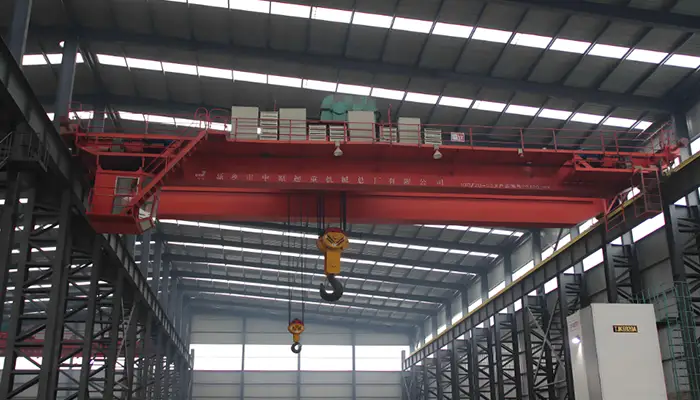
Double girder overhead cranes are pivotal in heavy manufacturing and construction applications. Their design incorporates two parallel beams, delivering exceptional strength and stability, which allows for higher lifting capacities and enhanced performance.
Applications:
- Steel Mills: These cranes are vital for efficiently moving heavy steel rolls and large plates, playing a crucial role in production processes that require reliability and speed.
- Large Fabrication Shops: They are adept at handling oversized components and assemblies, ensuring precise positioning of materials, which is essential for quality fabrication.
- Construction Sites: Double girder overhead cranes excel at lifting heavy materials such as concrete slabs and steel girders, significantly facilitating construction efficiency and safety on site.
Key Features:
- High Lifting Heights: This feature maximizes workspace, enabling effective use of vertical space, which is particularly beneficial in environments with limited floor area.
- Customizable Hoisting Mechanisms: These cranes can be tailored to suit specific lifting requirements, including adjustable speeds that cater to various tasks, enhancing operational flexibility.
- Safety Enhancements: Equipped with advanced safety features, such as load limiters and emergency stop functions, double girder overhead cranes help prevent accidents and ensure safe operation in demanding environments.
Double girder overhead cranes are integral to heavy lifting tasks across diverse industries, combining robust design with advanced features to meet the challenges of modern manufacturing and construction.
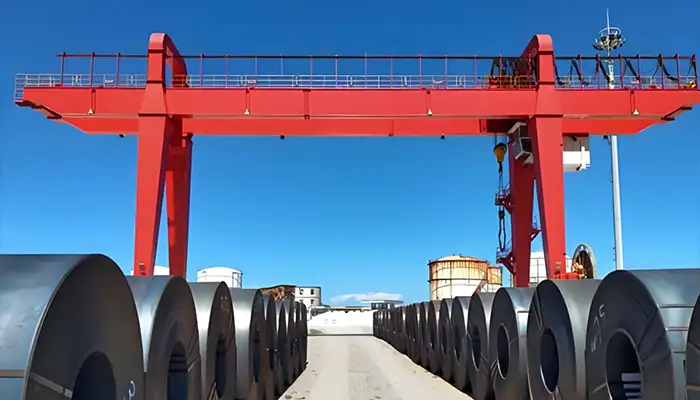
Double Girder Gantry Cranes
Heavy-duty gantry cranes are versatile lifting solutions engineered for the efficient handling of large components. Their robust construction and flexible design make them suitable for various demanding applications across different industries.
Applications:
- Shipyards: These cranes facilitate the movement of large ship components, including hulls and engines, during both construction and maintenance phases, ensuring seamless operations.
- Manufacturing Facilities: They are essential for transporting heavy machinery and materials throughout production processes, helping to maintain a smooth workflow and enhance productivity.
- Construction Sites: Double girder gantry cranes are adept at handling substantial loads, such as steel plates and concrete beams, which are critical for executing large-scale construction projects efficiently.
Key Features:
- Mobility Options: Available in both rail-mounted and rubber-tyred configurations, these cranes offer flexibility in operation across various surfaces, adapting to different site requirements.
- High Safety Standards: Equipped with features like anti-collision systems, overload protection, and user-friendly controls, these cranes prioritize operational safety and ease of use for operators.
- Robust Structural Integrity: Designed to handle extreme loads, double girder gantry cranes provide reliable performance in critical environments, ensuring durability and stability during heavy lifting tasks.
The classifications and types of heavy-duty cranes in China emphasize the importance of selecting the right equipment for specific operational needs. This ensures safety, efficiency, and productivity in heavy lifting tasks across diverse industries.
Key Considerations When Selecting Heavy-Duty Cranes
Selecting the right heavy-duty crane involves careful evaluation of several critical factors. Here's a breakdown of the key considerations:
Load Capacity
Assessment: Determine the maximum load the crane will need to lift.
Importance: Choosing a crane with a capacity that exceeds your needs is essential for ensuring safety and reliability during operations.
Operational Duty Cycle
Assessment: Evaluate how frequently the crane will be used.
Recommendation: For continuous operations, opt for cranes from higher classifications (e.g., Class F or A8) designed to handle prolonged use without overheating.
Environment
Assessment: Consider the operational environment.
Recommendation: If the crane will be exposed to extreme temperatures, corrosive conditions, or dusty environments, select models with appropriate protective features to enhance durability.
Space Constraints
Assessment: Evaluate the workspace layout.
Recommendation: Overhead cranes typically require more vertical clearance, while gantry cranes can offer greater flexibility in confined spaces, making them suitable for tighter environments.
Mobility Needs
Assessment: Decide whether a fixed or mobile crane is required.
Recommendation: Gantry cranes often provide greater mobility, advantageous in dynamic work environments that require frequent repositioning.
Safety Features
Assessment: Prioritize advanced safety systems.
Recommendation: Look for cranes equipped with overload protection, emergency stop functions, and user-friendly controls to enhance operational safety.
Compliance Standards
Assessment: Ensure adherence to local regulations and industry standards.
Importance: Compliance can vary significantly between regions, such as the USA and China, impacting operational legality and safety.
Supplier Support
Assessment: Choose a reputable supplier.
Importance: Opt for suppliers that offer quality equipment and comprehensive after-sales service, including maintenance and technical support, to ensure long-term operational success.
Customization Options
Assessment: Look for flexibility in crane features.
Recommendation: Consider cranes that can be tailored to meet specific operational needs, such as adjustable lifting speeds or specialized hoisting systems to enhance functionality.
By understanding these key distinctions and carefully evaluating each consideration, businesses can select the most suitable heavy-duty crane for their applications, ensuring efficiency, safety, and operational success. Contact us to get your customized heavy duty crane.
